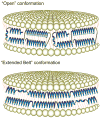Apolipoprotein E: from lipid transport to neurobiology
- PMID: 20854843
- PMCID: PMC3022415
- DOI: 10.1016/j.plipres.2010.09.001
Apolipoprotein E: from lipid transport to neurobiology
Abstract
Apolipoprotein (apo) E has a storied history as a lipid transport protein. The integral association between cholesterol homeostasis and lipoprotein clearance from circulation are intimately related to apoE's function as a ligand for cell-surface receptors of the low-density lipoprotein receptor family. The receptor binding properties of apoE are strongly influenced by isoform specific amino acid differences as well as the lipidation state of the protein. As understanding of apoE as a structural component of circulating plasma lipoproteins has evolved, exciting developments in neurobiology have revitalized interest in apoE. The strong and enduring correlation between the apoE4 isoform and age of onset and increased risk of Alzheimer's disease has catapulted apoE to the forefront of neurobiology. Using genetic tools generated for study of apoE lipoprotein metabolism, transgenic "knock-in" and gene-disrupted mice are now favored models for study of its role in a variety of neurodegenerative diseases. Key structural knowledge of apoE and isoform-specific differences is driving research activity designed to elucidate how a single amino acid change can manifest such profoundly significant pathological consequences. This review describes apoE through a lens of structure-based knowledge that leads to hypotheses that attempt to explain the functions of apoE and isoform-specific effects relating to disease mechanism.
Copyright © 2010 Elsevier Ltd. All rights reserved.
Figures





References
-
- Shimano H, Yamada N, Katsuki M, Shimada M, Gotoda T, Harada K, et al. Overexpression of apolipoprotein E in transgenic mice: marked reduction in plasma lipoproteins except high density lipoprotein and resistance against diet-induced hypercholesterolemia. Proceedings of the National Academy of Sciences of the United States of America. 1992;89:1750–4. - PMC - PubMed
-
- Zhang SH, Reddick RL, Piedrahita JA, Maeda N. Spontaneous hypercholesterolemia and arterial lesions in mice lacking apolipoprotein E. Science (New York, NY. 1992;258:468–71. - PubMed
-
- Ghiselli G, Schaefer EJ, Gascon P, Breser HB., Jr Type III hyperlipoproteinemia associated with apolipoprotein E deficiency. Science (New York, NY. 1981;214:1239–41. - PubMed
-
- Zannis VI, McPherson J, Goldberger G, Karathanasis SK, Breslow JL. Synthesis, intracellular processing, and signal peptide of human apolipoprotein E. The Journal of biological chemistry. 1984;259:5495–9. - PubMed
Publication types
MeSH terms
Substances
Grants and funding
LinkOut - more resources
Full Text Sources
Other Literature Sources
Research Materials
Miscellaneous

